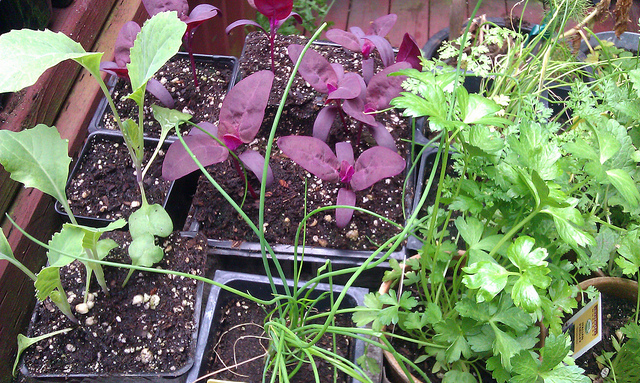The Lazy Gardener: Self-Seeding
We all know that perennial flowers will self-seed, keep growing, and come back again and again, making them great staples for the flower garden. But did you know that the same is true of many crops, as well? After all, plants are on a mission to perpetuate themselves, and while some have cleverly taken advantage of the fact that humans like to eat them so we do the work for them, others like to have a little insurance policy...so they produce their own seeds.
This can sometimes actually be a huge problem in the garden: both melons and tomatoes love self-seeding, but unfortunately, they're also highly promiscuous, so you never know what you're going to get from so called "volunteer" melons and tomatoes. Maybe a self-seeded plant will be the next great cultivar you've been waiting for, one with optimum sweetness, texture, and quality...or maybe the fruit will be ho-hum.
But fortunately, other plants are much more well behaved, and they can be great choices for a produce garden that will do part of the maintenance work for you. (Sorry, you're still going to have to water, fertilize, weed, watch out for pests, keep your fencing in order, and harvest.) These self-seeding crops will get themselves set up perfectly happily, and they'll relieve you of a lot of the spring stress of figuring out what to plant, when to plant it, and where to plant it.
 Crops that self-seed include: lettuce, dark leafy greens like kale and chard, broccoli, carrots, runner beans, celery, beets, arugula, parsnips, and radishes. You can also take advantage of self-seeding herbs like cilantro, dill, parsley, oregano, chives, chamomile, and basil (you'll need to bring basil plants in to overwinter because they don't like cold).
Crops that self-seed include: lettuce, dark leafy greens like kale and chard, broccoli, carrots, runner beans, celery, beets, arugula, parsnips, and radishes. You can also take advantage of self-seeding herbs like cilantro, dill, parsley, oregano, chives, chamomile, and basil (you'll need to bring basil plants in to overwinter because they don't like cold).
How do you take advantage of self-seeding? There are two options. The truly lazy gardener just lets plants go to seed, developing a stalk that produces flowers and later seeds, which will drop naturally into the area around the plant -- some of those seeds will also scatter on the wind, so your self-seeding pals may end up in places you didn't expect. (The self-seeding strategy is not for the gardener who craves rigid order.)
As a side bonus, letting crops flower creates an attractant for beneficial insects and birds. Making your garden more welcoming to wildlife makes it more sustainable and creates a more diverse habitat, which is good news!
Your other option is to let plants go to seed and then carefully cut the seed head and strategically scatter the seeds where you want them to go. (This strategy can also be used for seed saving, where you collect and save the seeds for next year instead of sowing them right away, and many self-seeding proponents also advise saving some seed in case things go wrong.) This allows for a little more control over where things end up and how they grow.
In both cases, be prepared: self-seeding crops can get a little out of control in your landscaping! You can help keep them in check by harvesting them and only letting a few go to seed (remember, even one plant can go a long way -- and keep in mind that you want to let your best plants go to seed to perpetuate the genes you like best). You're also going to need to thin seedlings as they come up in the following year, and you may want to consider potting them up to give away to friends.
Katie Marks writes for Networx.com.
Looking for a Pro? Call us (866) 441-6648

Landscaping Average Costs
Landscapers Experiences

Yard Cleanup And Lawn Care Service With A Great Work Ethic

Seamless Extension Of Concrete Patio And Poolside Retaining Wall



